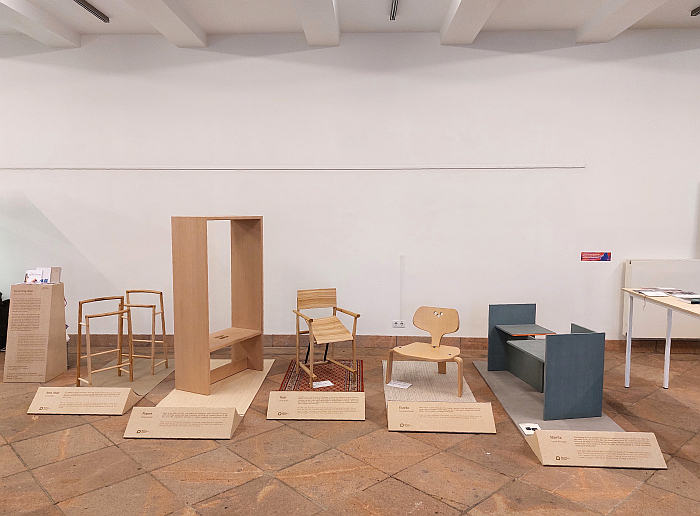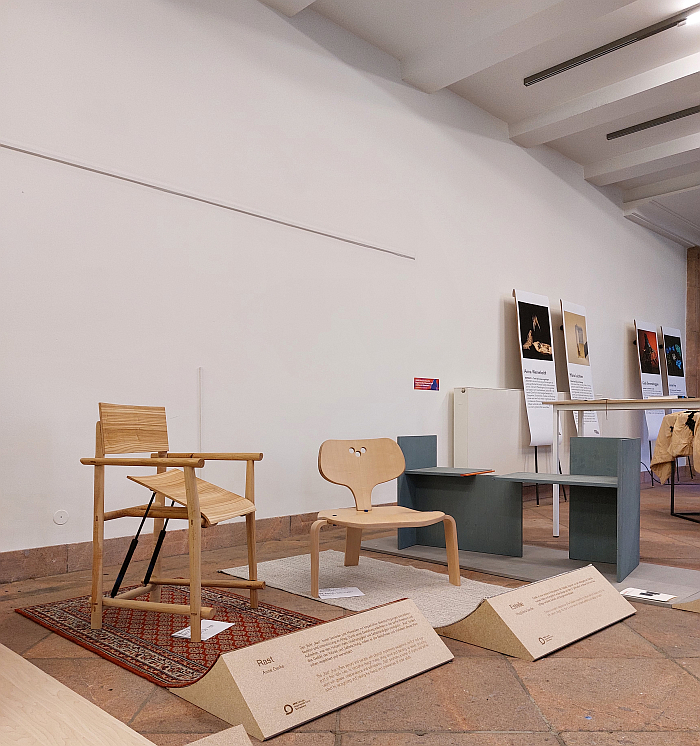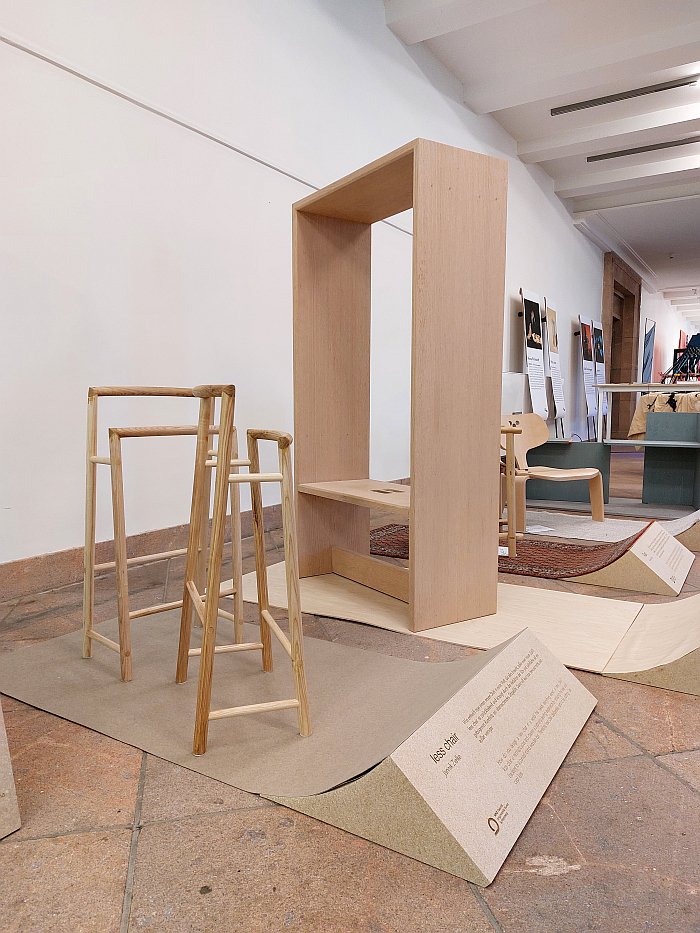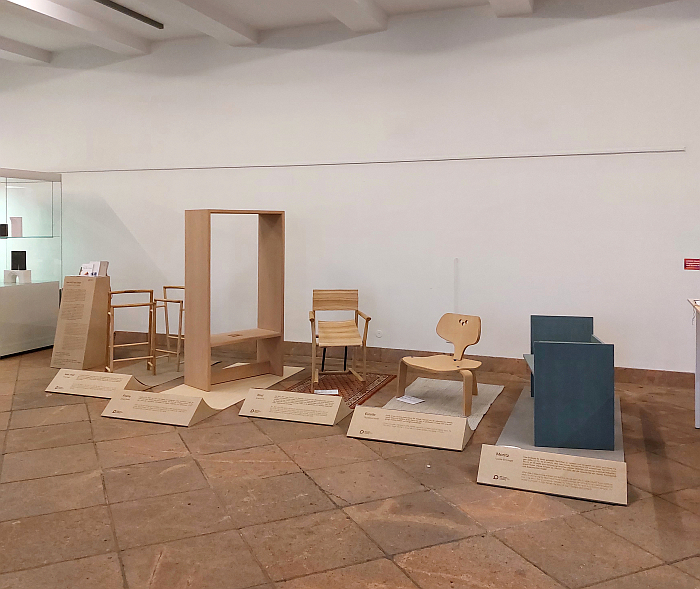
The exhibition A Chair and You at the Grassi Museum für Angewandte Kunst, Leipzig, may have ended but its traces can still be felt at Grassimesse 2024, being staged as it is to a large degree in the A Chair and You scenography. Or more accurately the A Chair and You colour and atmosphere scheme, the more extreme elements of Robert Wilson's scenography having been removed. And the soundtrack in the Orangerie set to mute.
And its traces can also be felt, if less directly, in the semester project Me and My Chair undertaken by Holzgestaltung students at the Faculty of Angewandte Kunst Schneeberg, a project that is one of several design school projects invited to participate at Grassimesse 2024; and a project in which having viewed A Chair and You asked the students to reflect on what 'a chair and you' means to them personally.
The result is five very different objects, five very different approaches to the term 'chair', different physically and different conceptually, be that the approach made by Louise Binninger's Moritz a chair inspired by the indefinite separation from her best friend 'Moritz', the reasons being a little too complex to explain at this juncture but those interested can explore the background (in German) here, a work that exists as two disjointed halves of a two-seater bench which can be joined together to create that unified bench should an opportunity arise, thus a work that succinctly, if for our taste a little to directly, transfers separation and the hope of reunion into a practical wooden furniture object. Albeit a thoroughly charming and very satisfying wooden furniture object. And two disjointed halves which Louise says are non-functional alone, but which we'd argue, and that at the risk of contradicting Louise which obviously we can't do as she designed it and we just engaged with it, we'd argue can be used alone just require the active support of the sitter to keep things upright: if the sitter doesn't support the chair it and you will crash to the floor. Which we'll argue is a second metaphor in the work.
And a contribution to the sitting experience by the sitter also demanded by less chair by Jannik Zielke, a work whose full name could be less chair, more frame, or less chair, more structure, or less chair, more bar stool amongst many other options; a work that can be used passively as a perch but if you want to sit on it requires being more aware of the object, requires the sitter taking on more responsibility for the act of sitting than is often the case with chairs, taking them all for granted as we do with their seats and backrests. And thus a work that demands a little more reflection on the act of sitting than one is accustomed to undertaking, but which is important that we all regularly do, not least to stop the seating industry taking us for granted to the degree we take our chairs. A work which, if no-one is perching or sitting on, you can throw clothes and similar over, less chair, more clothes horse, and thus a nice example of a multi-functionality that is always welcome in contemporary objects; and a visually light work, less chair, more implication, that should enable it to (appear to) take up a lot less space in any room than it actually does.

A visual lightness contrasted by its neighbour Frame by Johann Richter, a room-in-a-room, a chair, a space, a work that appears liberated from architecture, and in many regards is: Johann's inspiration was the bay window, a space often used as an extra sitting corner, one could also refer to the window seats of the castles of the Middle Ages or the window seats of Carl Larsson's illustrations of Lilla Hyttnäs, while the likes of a Gertrud Lincke or (a very early) Ludwig Mies van der Rohe often included sitting alcoves in their architecture to increase the amount of usable space. Johann has, in effect, plucked such from the the wall, or the window recess, and set it in space as object in which to sit separate from but part of the wider space, and thereby increases the amount of available space through differentiation and the transformation of volume to mass. An object very reminiscent of the great many room-in-a-room concepts a Verner Panton realised but whose wood in contrast to Panton's upholstery bequeaths Frame a calmness and serenity that should be effortlessly transposed to the sitter. Or sitters, for it unmistakably has something of the communal about it.
A sense of community differently implied by Rast by Anne Gerke a work that in contrast to the contribution demanded by less chair and Moritz assists the sitter, being as it is a work specifically conceived for the elderly and those with difficulties in getting in and out of chairs, and thus a work that reminds that furniture design needs must be inclusive, but rarely is, is normally exclusively for dominant groups. And a work that also implies community in the solidarity it expresses through enabling those who may need help to get in and out of conventional chair an independence, something that, again, contemporary society all to readily takes from those whose bodies are ageing quicker than their spirit. And while there, almost certainly, would be a craft solution, an extremely complex and costly craft solution, Anne's industrial solution not only reminds that industry is supposed to help society not the other way round, but should also keep the cost down, another important aspect of furniture design as inclusive. While leaving the industrial on show rather than seeking to hide it bequeaths Rast an honesty that aids and abets the arguments it advances and change it demands.
Thoughts on industry, craft and society also inherent in Estelle by Magdalena Sander a work inspired by the vernacular Stabelle chair, one of the oldest typologies of chair with its four legs and backrest inserted into a plank seat, and specifically the Stabelle built by Magdalena's father. And also inspired by the moulded plywood chairs of Charles and Ray Eames and of Alvar and Aino Aalto. A work that if one so will takes the vernacular craft of the Stabelle, the designed industrial of the Aalto's and Eames' moulded plywood and creates an object independent of, but dependent on, both. A contemporary work that wouldn't be possible without both the (hi)story of vernacular craft production and the (hi)story of designed industrial production, and thus a work that allows for reflection on the relationships between craft and industry, on the interplay between craft and industry, on the relevance of craft and industry in context of the development of our objects of daily goods that was also demanded by exhibitions such as, and amongst others, Craft as Myth. Between Ideal and Real Life at the Museum Angewandte Kunst, Frankfurt, or Glass – Hand Formed Matter at the Bröhan Museum, Berlin. Or through the work of a Michael Thonet.
Thus five chairs, a project, that also allows for reflection on that state of affairs discussed by and from A Chair and You, and also from the smow pop-up Stühle zum (Be)Sitzen, at the Grassi Museum für Angewandte Kunst, that there is always an active demand for more chairs because chairs have long since stopped being objects simply for sitting on and have taken on all manner of tangible and intangible, theoretical and practical, technically functional and emotional functional, aspects and contexts in the life of the human species. Have become integral to the life of the human species. And that for all that chairs are always anonymous mass market objects the are also always individual personal objects, are simultaneously a chair and you and a me and my chair.
Me and My Chair and all other projects selected or invited to participate in the 2024 Grassimesse Leipzig can be enjoyed, viewed, engaged with until Sunday October 27th at the Grassi Museum für Angewandte Kunst, Johannisplatz 5-11, 04103 Leipzig.
Full details of the 2024 Grassimesse, including opening hours and ticket prices, can be found at www.grassimesse.de
And more information on the Holzgestaltung Bachelor and Master courses at the Faculty of Angewandte Kunst Schneeberg can be found at www.fh-zwickau.de/holzgestaltung

